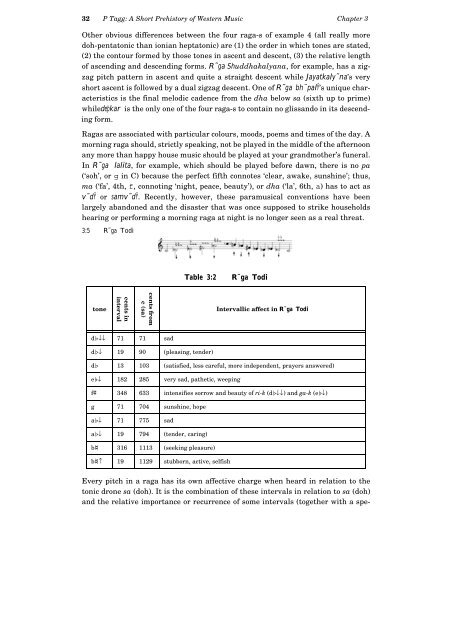A Short Prehistory of Western Music, Chapter 3
A Short Prehistory of Western Music, Chapter 3
A Short Prehistory of Western Music, Chapter 3
Create successful ePaper yourself
Turn your PDF publications into a flip-book with our unique Google optimized e-Paper software.
32 P Tagg: A <strong>Short</strong> <strong>Prehistory</strong> <strong>of</strong> <strong>Western</strong> <strong>Music</strong> <strong>Chapter</strong> 3<br />
Other obvious differences between the four raga-s <strong>of</strong> example 4 (all really more<br />
doh-pentatonic than ionian heptatonic) are (1) the order in which tones are stated,<br />
(2) the contour formed by those tones in ascent and descent, (3) the relative length<br />
<strong>of</strong> ascending and descending forms. R˜ga Shuddhakalyana, for example, has a zigzag<br />
pitch pattern in ascent and quite a straight descent while Jayatkaly˜na’s very<br />
short ascent is followed by a dual zigzag descent. One <strong>of</strong> R˜ga bh¨palŸ’s unique characteristics<br />
is the final melodic cadence from the dha below sa (sixth up to prime)<br />
while deþkar is the only one <strong>of</strong> the four raga-s to contain no glissando in its descending<br />
form.<br />
Ragas are associated with particular colours, moods, poems and times <strong>of</strong> the day. A<br />
morning raga should, strictly speaking, not be played in the middle <strong>of</strong> the afternoon<br />
any more than happy house music should be played at your grandmother’s funeral.<br />
In R˜ga lalita, for example, which should be played before dawn, there is no pa<br />
(‘soh’, or g in C) because the perfect fifth connotes ‘clear, awake, sunshine’; thus,<br />
ma (‘fa’, 4th, f, connoting ‘night, peace, beauty’), or dha (‘la’, 6th, a) has to act as<br />
v˜dŸ or samv˜dŸ. Recently, however, these paramusical conventions have been<br />
largely abandoned and the disaster that was once supposed to strike households<br />
hearing or performing a morning raga at night is no longer seen as a real threat.<br />
3:5 R˜ga Todi<br />
tone<br />
cents in<br />
interval<br />
cents from<br />
c (sa)<br />
d$↓↓ 71 71 sad<br />
d$↓ 19 90 (pleasing, tender)<br />
Table 3:2 R˜ga Todi<br />
Intervallic affect in R˜ga Todi<br />
d$ 13 103 (satisfied, less careful, more independent, prayers answered)<br />
e$↓ 182 285 very sad, pathetic, weeping<br />
f# 348 633 intensifies sorrow and beauty <strong>of</strong> ri-k (d$↓↓) and ga-k (e$↓)<br />
g 71 704 sunshine, hope<br />
a$↓ 71 775 sad<br />
a$↓ 19 794 (tender, caring)<br />
b8 316 1113 (seeking pleasure)<br />
b8↑ 19 1129 stubborn, active, selfish<br />
Every pitch in a raga has its own affective charge when heard in relation to the<br />
tonic drone sa (doh). It is the combination <strong>of</strong> these intervals in relation to sa (doh)<br />
and the relative importance or recurrence <strong>of</strong> some intervals (together with a spe-














